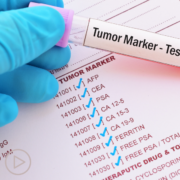How Do Biomarker Test Results Impact Prostate Cancer Treatment Options?
How Do Biomarker Test Results Impact Prostate Cancer Treatment Options? from Patient Empowerment Network on Vimeo.
What can biomarker test results indicate about prostate cancer treatment options? Dr. David Wise discusses genetic mutations, treatment classes, and testing methods that are commonly examined to help determine optimal prostate cancer approaches.
Dr. David Wise is Director of Genitourinary Medical Oncology at the Laura and Isaac Perlmutter Cancer Center at NYU Langone Health. Learn more about Dr. Wise.
See More From INSIST! Prostate Cancer
Related Resources

|

Prostate Cancer Testing: What Tests Should You Advocate For? |

How Do Biomarker Test Results Impact a Prostate Cancer Patient’s Prognosis? |
Transcript:
Dr. David Wise:
So, that’s a great question. So, there are multiple gene test results that can directly influence a choice of treatment. I think that it’s important to highlight two main categories, both within the genomic testing setting. Both of these test results have their major impact in patients with metastatic prostate cancer, whether the cancer has been treated already and is resistant to current treatments, or even some situations where the cancer has not even been treated.
For metastatic prostate cancer, I think it’s important to assess whether the cancer has evidence of a BRCA1 or 2 mutation, or whether the cancer has evidence of a genetic feature called microsatellite instability, or MSI high. Cancers that have evidence of BRCA1 or 2 have clear benefit. Patients have clear benefit from treatment that targets those genes. And that’s a class of oral medications called PARP inhibitors, several of which are already FDA-approved for hormone-resistant metastatic prostate cancer with evidence of BRCA1 or 2 mutation.
There are even newer clinical trials which are testing the use of those medicines at the outset of men who are initially diagnosed with metastatic prostate cancer, even naïve to treatment and testing whether we should be adding on PARP inhibitors for men with that genetic feature.
Microsatellite instability, as well, leads to a clear FDA indication for immunotherapy with what we call checkpoint inhibitors that target and reinvigorate the body’s immune system. We know that prostate cancers with that particular genetic feature, which unfortunately is still an uncommon type of prostate cancer – but when it happens, it’s important to know about it because those immunotherapies can have truly life-changing, truly very long lasting, in the order of years, benefit to keeping that cancer to an undetectable level. Now, I would say, those are the key genomic features that directly translate to changes in treatment.
There are other biomarkers, one we haven’t talked about which is very impactful, which is levels of PSMA expression on a PET scan. So, we talked about that in the setting of making a diagnosis, but it also is important for dictating best treatment. So, we now know, based on the results of a large Phase III trial that patients with prostate cancers that have PSMA uptake on PET imaging, which is an imaging biomarker, not a genetic biomarker, but an imaging biomarker.
Those patients respond quite well to lutetium PSMA, which is a radioligand therapy that targets PSMA-producing prostate cancers. And so, those are examples of, I think, very impactful biomarkers that patients need to know about, so that they can ask their physicians to get tested to see if they’re candidates for those potential treatments.
So, the genetic tests can be done either on biopsy material or on blood. And the latter has really been a major advance because we’ve been able to identify patients who are eligible without exposing them to an additional fresh biopsy. Sometimes, we need to because sometimes the blood does not have sufficient material to be able to establish the diagnosis. But still, it is often worth trying because, of course, we would try to do anything to avoid undergoing a risky procedure, and this is an example of that. In order to assess hereditary genetic risk, that can be done from a saliva sample. So, often, a cheek swab is enough, but testing for that is often pretty standard as well. So, that’s another option.
So, in order to assess PSMA expression, which lends itself directly to the use of lutetium PSMA, that’s the straightforward PET scan. It’s now something that is readily available at the vast majority of academic centers and in the community as well.










